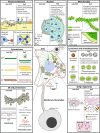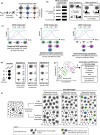Subcellular structure, heterogeneity, and plasticity of senescent cells
- PMID: 38553952
- PMCID: PMC11019148
- DOI: 10.1111/acel.14154
Subcellular structure, heterogeneity, and plasticity of senescent cells
Abstract
Cellular senescence is a state of permanent growth arrest. It can be triggered by telomere shortening (replicative senescence) or prematurely induced by stresses such as DNA damage, oncogene overactivation, loss of tumor suppressor genes, oxidative stress, tissue factors, and others. Advances in techniques and experimental designs have provided new evidence about the biology of senescent cells (SnCs) and their importance in human health and disease. This review aims to describe the main aspects of SnCs phenotype focusing on alterations in subcellular compartments like plasma membrane, cytoskeleton, organelles, and nuclei. We also discuss the heterogeneity, dynamics, and plasticity of SnCs' phenotype, including the SASP, and pro-survival mechanisms. We advance on the multiple layers of phenotypic heterogeneity of SnCs, such as the heterogeneity between inducers, tissues and within a population of SnCs, discussing the relevance of these aspects to human health and disease. We also raise the main challenges as well alternatives to overcome them. Ultimately, we present open questions and perspectives in understanding the phenotype of SnCs from the perspective of basic and applied questions.
Keywords: SASP; cellular senescence; dynamics; heterogeneity; subcellular structure.
© 2024 The Authors. Aging Cell published by Anatomical Society and John Wiley & Sons Ltd.
Conflict of interest statement
No conflict of interest.
Figures



References
-
- Acosta, J. C. , Banito, A. , Wuestefeld, T. , Georgilis, A. , Janich, P. , Morton, J. P. , Athineos, D. , Kang, T. W. , Lasitschka, F. , Andrulis, M. , Pascual, G. , Morris, K. J. , Khan, S. , Jin, H. , Dharmalingam, G. , Snijders, A. P. , Carroll, T. , Capper, D. , Pritchard, C. , … Gil, J. (2013). A complex secretory program orchestrated by the inflammasome controls paracrine senescence. Nature Cell Biology, 15(8), 978–990. 10.1038/ncb2784 - DOI - PMC - PubMed
-
- Adams, T. S. , Schupp, J. C. , Poli, S. , Ayaub, E. A. , Neumark, N. , Ahangari, F. , Chu, S. G. , Raby, B. A. , DeIuliis, G. , Januszyk, M. , Duan, Q. , Arnett, H. A. , Siddiqui, A. , Washko, G. R. , Homer, R. , Yan, X. , Rosas, I. O. , & Kaminski, N. (2020). Single‐cell RNA‐seq reveals ectopic and aberrant lung‐resident cell populations in idiopathic pulmonary fibrosis. Science Advances, 6(28), eaba1983. 10.1126/sciadv.aba1983 - DOI - PMC - PubMed
-
- Aguayo‐Mazzucato, C. , Andle, J. , Lee, T. B. , Midha, A. , Talemal, L. , Chipashvili, V. , Hollister‐Lock, J. , van Deursen, J. , Weir, G. , & Bonner‐Weir, S. (2019). Acceleration of β cell aging determines diabetes and Senolysis improves disease outcomes. Cell Metabolism, 30(1), 129–142.e124. 10.1016/j.cmet.2019.05.006 - DOI - PMC - PubMed
-
- Aguayo‐Mazzucato, C. , van Haaren, M. , Mruk, M. , Lee, T. B. , Crawford, C. , Hollister‐Lock, J. , Sullivan, B. A. , Johnson, J. W. , Ebrahimi, A. , Dreyfuss, J. M. , van Deursen, J. , Weir, G. C. , & Bonner‐Weir, S. (2017). β cell aging markers have heterogeneous distribution and are induced by insulin resistance. Cell Metabolism, 25(4), 898–910.e895. 10.1016/j.cmet.2017.03.015 - DOI - PMC - PubMed
Publication types
MeSH terms
Grants and funding
LinkOut - more resources
Full Text Sources

